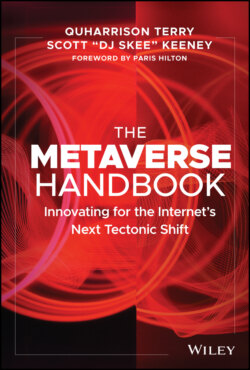Читать книгу The Metaverse Handbook - QuHarrison Terry - Страница 7
Extended Reality Emerges
ОглавлениеThe year 2022 brought many of the same narratives we heard back in the early 2000s, except under the new moniker of “the Metaverse.” The commercial narrative hasn't changed much. Most brands view the Metaverse as a way to disguise an advertisement within the confines of a virtual experience, except that now the tech has completely changed.
Today, virtual worlds are largely being built on the back of the blockchain. Blockchain is a digital ledger that records transactions and information maintained and duplicated across a peer-to-peer network of computers, making it nearly impossible to record, edit, and hack false transactions. This allows creators to build digital scarcity into the social experience, turning everything from the game's land to the accessories our avatars equip into nonfungible tokens (NFTs). With blockchain as a new foundation of the Metaverse, the narrative has shifted to building a future that is user-owned, user-built, and ultimately for the user to reap the rewards. This is the rallying cry of the Metaverse today. It's an upgraded promise from the early Metaverses that were primarily social experiences with the occasional commercial opportunity.
Now, everyone is just $300 USD away from immersing themselves in a very impressive virtual reality experience. Consumer-ready virtual reality (VR) wasn't an option when Coca-Cola was building CC Metro. Furthermore, augmented reality (AR)—a real-world overlay of graphics and computer-generated information experienced through devices such as smartphones and smart glasses—was still the stuff of science fiction in the CC Metro world. The immersive technologies of VR and AR that are instrumental in the experience of the Metaverse are collectively known as extended reality (XR).
While current Metaverses like Decentraland are still accessed through the web browser, they will eventually collide with XR. The true vision of the Metaverse promises shared virtual experiences. And that is now in the realm of possibility for all builders, brands, and individuals.
In an interview with The Information, John Riccitiello, the CEO of Unity Technologies, predicts that VR/AR headsets will be as common as gaming consoles by 2030. With 250 million households owning gaming consoles worldwide, he is not predicting ubiquity on the level of the 4 billion smartphones worldwide. Rather, John sees XR as shared devices, like your game system or TV, which is a sentiment we largely agree with.
XR is an innovation in communication. Of course, gaming, entertainment, and commerce are great use cases for extended reality. And these experiences will make a significant impact on enticing people to use XR platforms. But it's the social experience that XR can facilitate that will make these devices so sticky for users. It makes you wonder how things would have been different for There.com if Meta's Oculus Quest 2 VR headset was around back then. But that's beside the point.
Ten years from now, XR and the Metaverse will be part of most of our lives. But how do we get to the point where nearly every household owns an XR headset and is accessing the Metaverse regularly? What Metaverse apps and experiences are onboarding people into the Metaverse today that will become the pillars of the Metaverse in 2032?
To answer these questions, we'll first look at the idea of personal Metaverses or Metaverse homes.
